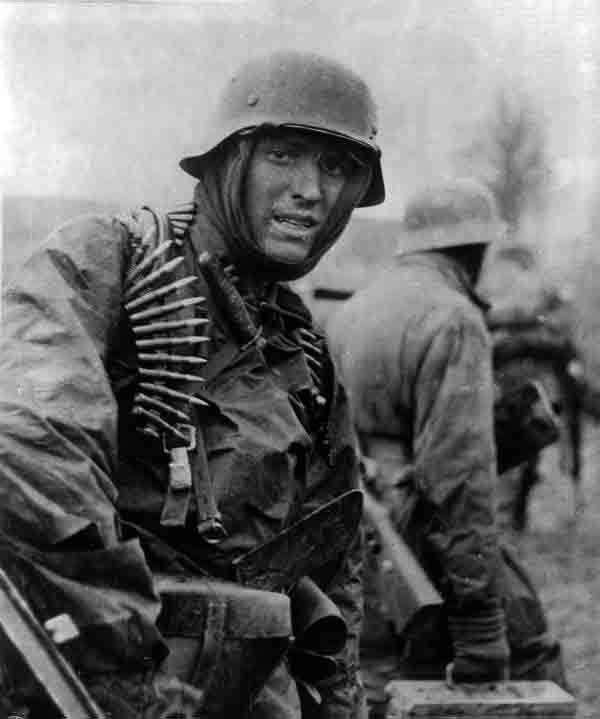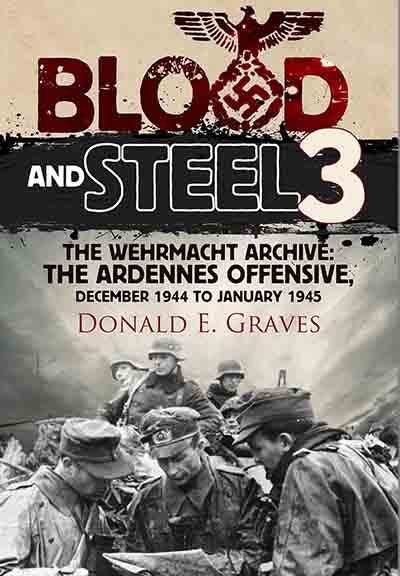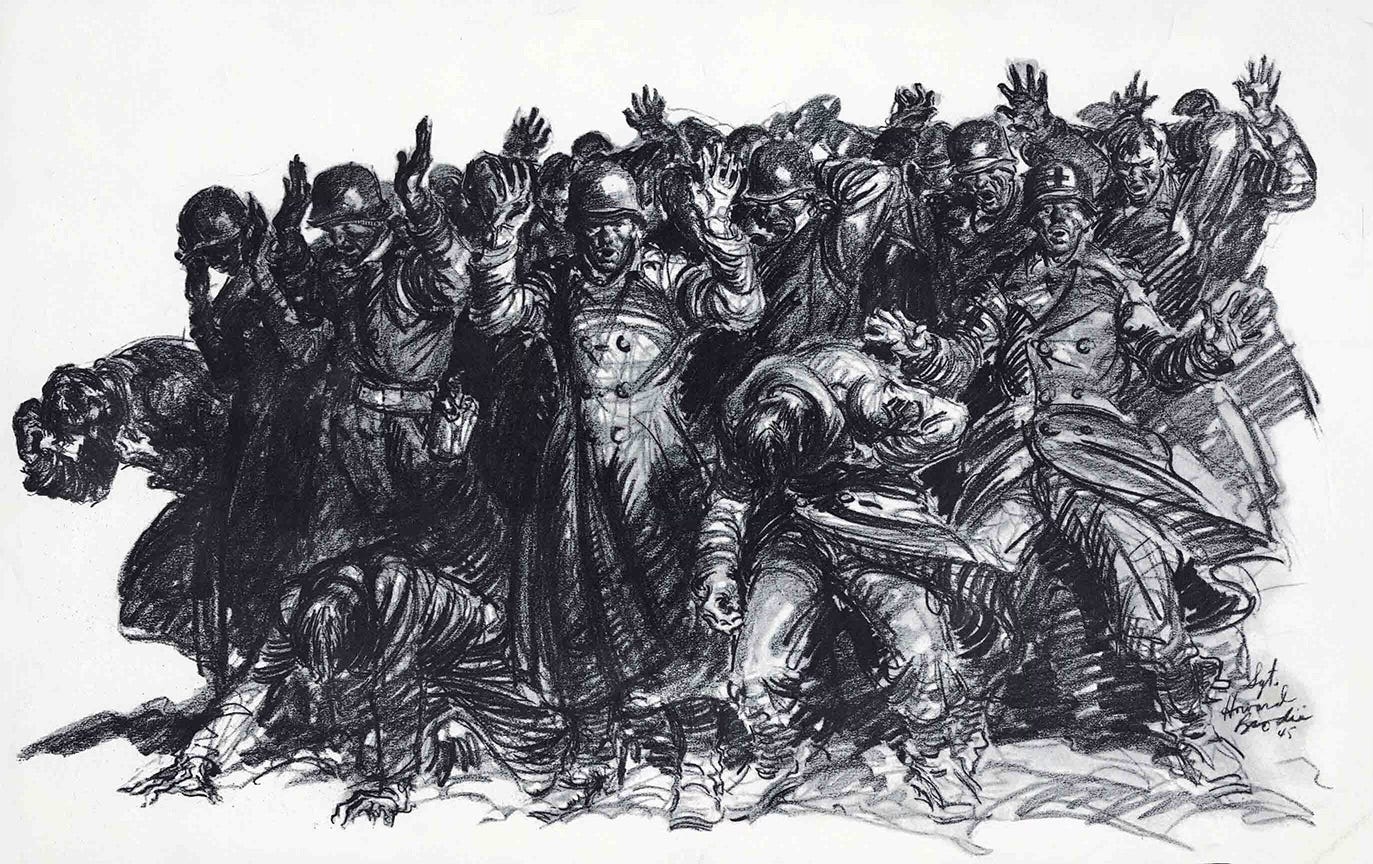'Blood and Steel 3'
Two excerpts from a collection of mainly German accounts of the Battle of the Bulge ... and links to recent stories from the battle 80 years ago ...
Canadian historian Donald E. Graves followed up his successful volumes on Normandy and the aftermath ( Blood and Steel and Blood and Steel 2) with a third collection of German material gathered by Allied intelligence that paints an immediate and direct picture of their perspective. Blood and Steel 3: The Wehrmacht Archive: The Ardennes Offensive, December 1944 to January 1945, provides an equally valuable insight into the attitudes of a diverse group of German troops, from senior commanders down to Landsers on the front line.
World War II Today is Currently 50% Off !
The following two excerpts cover some of the events at the Belgium village of La Gleize. The first is unusual for this volume as it is the account of a US Army officer. Major Hal D. MacCowan, commander of the 2nd Battalion, 119th Infantry Regiment, had been captured on the afternoon of the 21st December, when a German patrol suddenly surrounded him and his radio operator.
The patrol came from Kampfgruppe Peiper and he was taken back to their HQ in the La Gleize. At the time he was unaware of the atrocities committed by Kampfgruppe Pieper:
During the entire time I was in this town I gathered all the information I could from other captives as well as German officers and men (who talked to a surprising degree) about the strength, disposition and condition of the Germans in that area. The Germans in the La Gleize pocket were part of the 1st Panzer SS Division Adolf Hitler. Lieutenant-Colonel Pieper - normally a regimental commander - commanded this column which consisted of more than his normal command.
I learned later that the La Gleize pocket consisted of only a portion of his column, a considerable portion being near Stavelot, the remainder near Trois Ponts and further back on the route of the breakthrough.
Initial orders to Colonel Pieper contained the information that he could not expect supplies from the rear during the attack, that he would capture both petrol and food for subsistence. Extra ammunition was carried and strict orders against wastage of ammunition was emphasized.
I did my best to determine the objectives of this unit and gained from several sources among the German officers and men that this Division would be the first element in Liege and Maastricht. Colonel Pieper questioned me fruitlessly several times about road and bridge conditions in the Maastricht area.
An amazing fact to me was the youth ofthe members ofthis organization - the bulk of the enlisted men were 18 or 19 years of age, recently recruited but from my observations thoroughly trained. There was a good sprinkling of both Privates and NCOs from the years of Russian fighting. The officers for the most part were veterans but were also very young. Colonel Peiper was 29 years old, his tank battalion commander was 30; his captains and lieutenants ran from 19 years to 27 years of age.
The morale was high throughout the entire period I was with them despite the extremely trying conditions. The discipline was very good. The noise discipline on the night movements - which I will mention later - was so perfect that I could hardly believe that they could accomplish it. The physical condition of all personnel was good, except for a lack of proper food which was apparent more strongly just before I escaped from the unit.
The equipment was good and complete with the exception of some reconditioned half-tracks among the motorized equipment. All men wore practically new boots and had adequate clothing. Some of them wore parts of American uniforms, mainly the knit cap, gloves, sweaters, overshoes, and one or two overcoats. I saw no one, however, in American uniforms or in civilian clothes. The relationship between the officers and men, particularly the commanding officer, Colonel Pieper, was closer and more friendly than I would have expected. On several occasions Colonel Pieper visited his wounded and many times I saw him give a slap of encouragement on the back of heavily loaded men as we were climbing the steep hills, and speak a couple of cheering words.
He was completely confident of Germany’s ability to whip the Allies.
Later on during the night of 21 December at approximately 2300 I was again taken to the cellar headquarters of Colonel Pieper. I found him in a very much different mood than the cold impersonal attitude which he used formerly. He and I talked together from 2300 to 0500 the next morning - our subject being mainly his defence of Nazism and why Germany was fighting.
I have met few men who impressed me in as short a space of time as did this German officer. He was approximately 5 feet 8 inches in height, 140 lbs in weight, long dark hair combed straight back, straight well-shaped features, with a remarkable facial resemblance to the actor Ray Milland. He is the holder of the Iron Cross with oak leaves and had fought in Russia for a long period of time and briefly at Mortain and Caen. He was completely confident of Germany’s ability to whip the Allies. He spoke of Hitler’s new reserve army quite at length, saying that it contained so many new divisions, both armoured and otherwise, that our IOs would wonder where they all came from.
He did his best to find out from me details ofthe success V-l and V-2 were having and told me that more secret weapons like those would be unloosed. He said a new submarine campaign is also opening up and that they had been told that there had been considerable tonnage sunk in the English Channel just recently by the new underwater attack. The German Air Force, he said, would now come forth with many new types and which - although inferior in number to the Allies - would be superior in quality and would suffice their needs to cover their breakthough in Belgium and Holland and later to the French coast.
Concerning treatment of prisoners by the SS, I can state that at no time were the prisoners of this organization mistreated. Food was scarce but it was nearly as good as that used by the Germans themselves. The American prisoners were always given cellar space to protect them from the exceedingly heavy American artillery barrages.
I was taken for a brief period to the main prison enclosure which was a large two-room, well-constructed cellar quite superior to any I saw in La Gleize. The men were considerably overcrowded and were allowing the guards to bully them a little. I organized the entire group of some 130 into sections, appointed a First Sergeant and laid down a few rules concerning rotation sleeping, urinating, equality and distribution of food, and got the German warrant officer in charge of the prisoners settled upon a fairer method of giving water to prisoners and providing ventilation.
Another account comes from the diary of Feldwebel Karl Laun, an NCO in charge of a Flak unit attached to Kampfgruppe Pieper. He was not happy to be serving alongside the SS:
20 December 1944
With dawn I return to our positions. I can’t believe it, but miraculously only one prime mover became scrap metal. Our bivouac area is punctured by artillery craters.
Without warning, a monstrous, abhorrent picture presents itself to me. Its horror slaps me in the face. Corpses of murdered soldiers. Soldiers, who after an honest fight, had surrendered to our paratroopers. They were then turned over to the SS who organized them into small groups of 6-8 men each for the purpose of the slaughter. Who of these SS bastards has even the slightest inkling of international law, or for that matter, of humanity? Nothing, absolutely nothing, is sacred to them, there they lie, those seven or eight US soldiers, without weapons or helmets, about three paces apart; evidently shot from behind, mute witnesses against a system of murder. They are the witnesses, but where is the prosecutor and where the judge? I know that up above there is a higher tribunal, and I’m certain if we down here don’t punish them, that a just Lord will do it unfailingly.
In the afternoon we advance in forced march tempo to a bridge in the direction of Cheneux. In the beginning, our mission is defined as ‘bridge protection’. But hardly have we reached our destination, when Peiper requisitions one of our platoons for infantry commitment. To an ever- increasing degree does the SS rely on the prowess of the Flak units, probably to refill their badly decimated ranks.
Somewhere in the night we hear the anguished screams of women.
The din in the village (Cheneux) is maddening, a fact to which I personally testify as I am selected to stay at the bridge. In vain do I try to point out to Herr Major Sacken that an employment of our pieces near the bridge is plain and simple suicide. For an incessant artillery and mortar fire seems to be zeroed in on this point. I inspect the first piece and already find one man of the crew wounded. He is evacuated. I return and hear p that another man has disappeared without leaving a trace; probably was expedited into the murky river by a hit. And then I find Lt Porep severely wounded. When I place the unfortunate guy at the Major’s feet, Sacken becomes concerned over his own safety. In the meantime, I have already taken it upon myself to order the survivors of my platoon to retreat.
In the meantime, the SS was cajoled into new positions behind Cheneux by threats, kicks, and curses of their officers. At night, American infantry counter-attacks twice. We suffer heavy casualties, while the Herren menschen sit in bunkers and basements. Prior to taking cover, they displayed their courage by ordering the herding together of all civilians in Staumont. Somewhere in the night we hear the anguished screams of women.
21 December 1944
A German counter-attack at dawn is stifled by enemy fire. Nobody shows any inclination to fight - not even the SS. As a matter of fact, they are the first ones to withdraw. Suddenly one of our tanks makes an appearance near the bridge. Again a frantic solicitation for gasoline. Draining all vehicles, including the Volkswagen, and the wrecked prime movers, we scrape 30 gallons together. The Tiger continues towards Cheneux.
I am darned glad that I don’t have to be in the inferno prevailing in that village. Down here the enemy artillery bursts have somewhat subsided. In the morning hours two of my best comrades and I are selected to form a Panzervernichtungstrupp (Anti-tank squad). Six Panzerfausts, one machine pistol - and now we constitute a formidable force which will be able to stop all enemy tanks. Our battle plans concentrate around the selection of the most favourable route of withdrawal.
… accompanied by some sizzling hot farewell messages from the Americans.
Everything at our old AA position is quiet now. The piece lies by the roadside nearly segmented. I am just about to inspect one of my platoon’s quadruple guns, when all of a sudden twelve Americans, shouting continuously, their rifles and MPs raised above their heads, break out of a thicket. They shout ‘Nicht schiessen’ [Don’t shoot]. At first I think this is a ruse and tell my men to go into firing position, but then I recollect the [Operation] Greiff boys. Yes, indeed, it’s these lads who have returned, accompanied by some sizzling hot farewell messages from the Americans. They posed as the 88th HQ Coy, but the Yankees refused to swallow it. The ‘gangs’ as they call themselves, at once change uniforms and the gangsters continue fighting as harmless anti-aircraft boys.
I don’t know how it came about, certainly nobody gave orders to this effect, but suddenly everything on the Cheneux highway is making a dash for our bridge. There is no more stopping; the situation has become hopeless. I swing aboard the first vehicle that comes along and we make a mad dash for La Gleize. In front of a bridge, the SP gun, overloaded with its human cargo, starts sliding and I pick myself out of a ditch. In the meantime, the Americans have been able to occupy the heights to the right (east) of the road and their guns pay careful attention to all vehicular movement. I barely succeed in clamping myself onto a passing truck to escape towards La Gleize.
The town has changed since we passed through here on our way to the grand attack. The old burg is aflame on all corners. I run into old acquaintances. Even the action Greiff, those scalped Indians, who I already saw at Losheim, make another appearance here. Nobody thinks of placing a gun into position although this constitutes a direct violation of the orders of Herr Major Sacken. Fortunately for us, the American artillery seems to be taking a break too. There is a cold drizzle and if somebody would have tapped me on the shoulder and said ‘Hands up, come along’, I think there would not have been a happier person in the world.
22 December 1944
This morning we get new orders: to throw a perimeter defence around La Gleize. With this order the Landsers begin to realize that we are cut off and encircled. I had a premonition of this. Like a flash, I realize the deadly seriousness of the situation. Should the Yanks catch us here together with the SS - caught together, hung together. And those SS madmen may want to fight to the last man - including us ...
The boys of my platoon have become taciturn; passively they have accepted their fate. Like robots they go through the motions of carrying out the orders which I pass down from the Battery CO. I know darn well that only utmost alertness and interest could see the men through in this critical moment, but these qualities are lacking as much as the motor fuel in the gas tanks.
We occupy the SE side of La Gleize, facing the railway bridge. Everybody digs and claws to gain the slight cover mother earth can afford. With a woodsaw we fell a few trees and roll them over our foxholes as protection against shrapnel. We add a few shovelfuls of dirt and place a prime mover right over a 4-man slit trench. This improved bunker serves only as inadequate shelter against those Yank mortars.
On the other side of the river we spot American infantry. Our propaganda machine at once starts to work: ‘You see, boys, the Americans are retreating .. In the evening the American artillery cuts loose. We crawl into our trenches like moles. Hunger overpowers me, but in spite of this, I don’t dare to get one of my booty US rations only about 30 yards away. The artillery shells fall as quick as hail into our positions.
©Donald E Graves 2015, 'Blood and Steel 3: The Wehrmacht Archive: The Ardennes Offensive, December 1944 to January 1945'. Reproduced courtesy of Pen & Sword Publishers Ltd.









Every Waffen-SS scum should have gotten a bullet in the head upon capture, in line with the Geneva Convention punishments for civilians impersonating soldiers on the battlefield, the SS being Hitler's private army and not a part of the Wehrmacht.